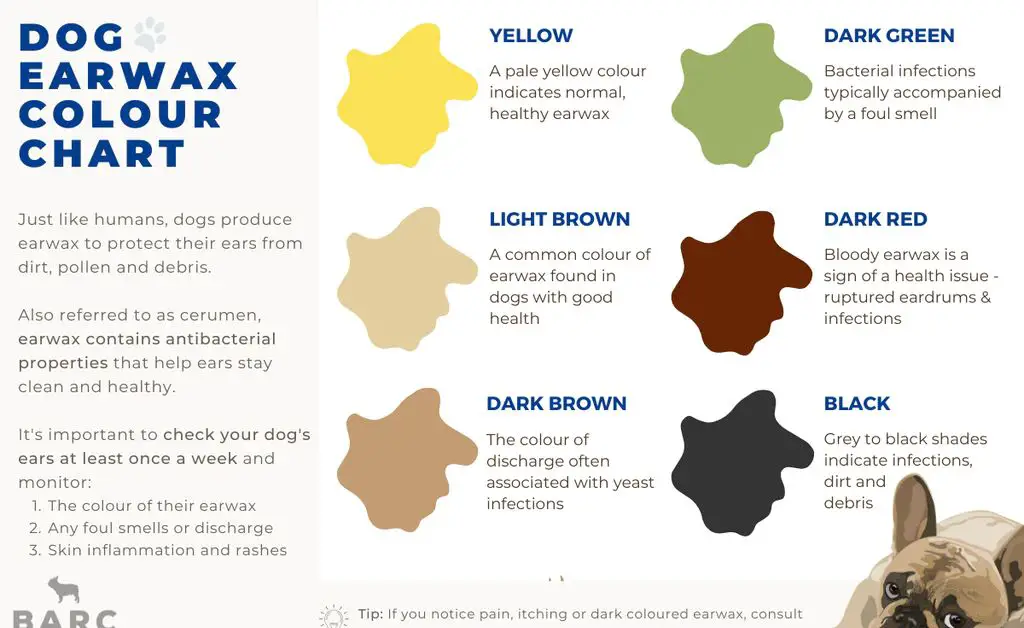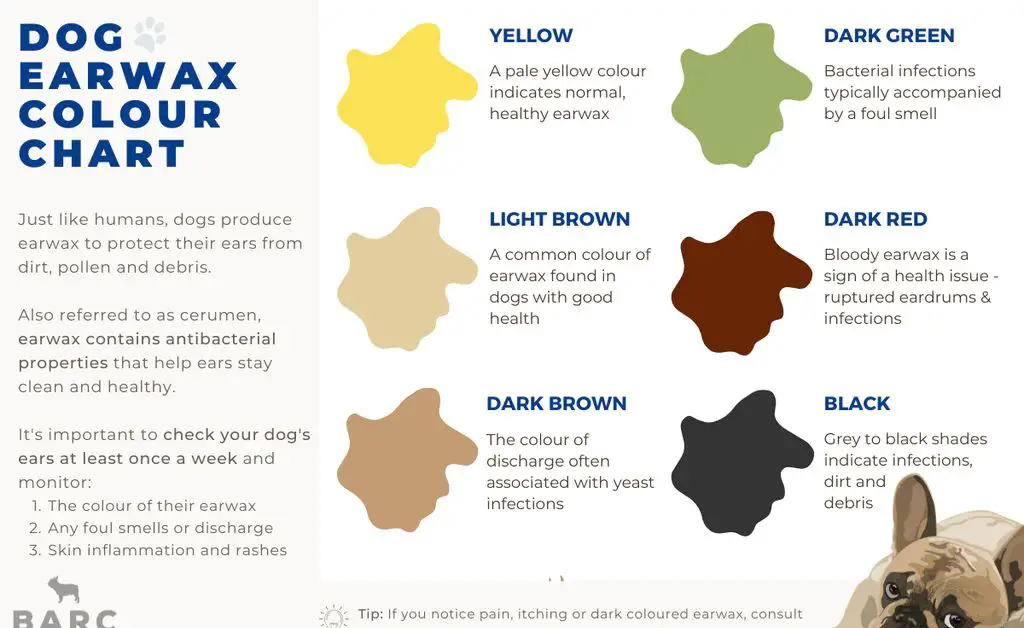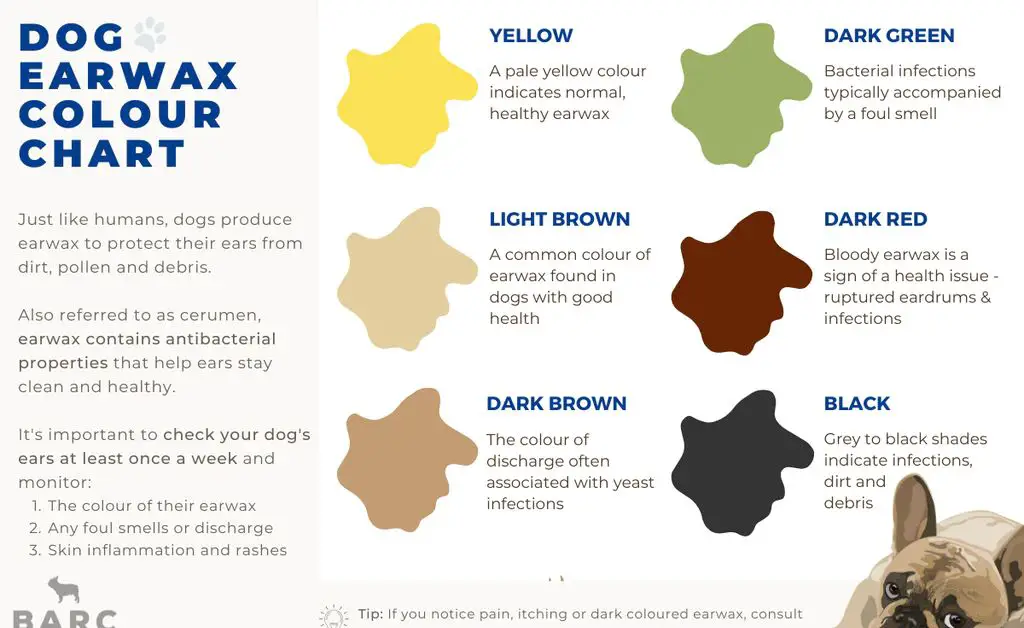Causes of Dark Brown Ear Wax in Dogs
The color of a dog’s ear wax can range from light yellow to dark brown or black. While mild discoloration is usually normal, dark brown or black ear wax may indicate underlying health issues. There are several potential causes of abnormally dark ear wax in dogs:
Breed Predispositions
Certain dog breeds are more prone to producing darker ear wax, including Retrievers, Poodles, Cocker Spaniels, Miniature Schnauzers, and Shar Peis. These breeds have hair growth deep in their ear canals which traps debris and leads to increased wax production. The hair also causes the wax to turn darker in color.

Diet
Diet can influence ear wax color and consistency. Food allergies or sensitivities may cause inflammation and excess wax production. Diets high in oils and fats can also increase wax buildup. Changing to a high-quality diet formulated for a dog’s age and activity level may help return ear wax to a lighter, healthier color.
Environmental Factors
Exposure to dirt, moisture, pollen, and other irritants can cause irritation and inflammation in a dog’s ears. This leads to increased secretions in the ear canal, causing wax to darken. Swimming, bathing, seasonal allergies, and unclean environments all contribute to dark ear wax.
Diagnosing the Cause
If your dog has dark brown ear wax, the first step is to take them to the veterinarian for an examination. The veterinarian will look in your dog’s ears with an otoscope to inspect the ear canal and eardrum. They will check for any abnormalities, inflammation, or underlying conditions that could be causing the dark brown color.
Your veterinarian will also ask questions about your dog’s diet and environment to help identify any potential contributing factors. For example, they may ask what kind of food your dog eats, if they have access to fatty scraps or oils, and rule out any food allergies. The vet will also want to know about any access to dirt or debris, swimming habits, excessive head shaking or scratching, and use of ear cleansers or medications.
By thoroughly evaluating your dog’s ears, diet, and environmental exposures, the veterinarian can start piecing together what factors are most likely leading to the abnormal dark brown ear wax.
Dietary Considerations
A dog’s diet can have a significant impact on the color and consistency of their ear wax. High fat diets, food allergies, and nutritional deficiencies are some dietary factors that may cause dark brown ear wax.

High fat diets provide more sebum production, which contributes to darker ear wax. The increased sebum moisturizes the ear canal but also increases wax production. High fat dog foods to avoid include those with increased meat protein and animal fats.
Allergies to proteins like chicken, beef, dairy, and eggs may cause inflammation and excess wax production. Signs include irritated skin, scratching, head shaking, and dark brown debris. Hypoallergenic dog foods with alternate protein sources may help reduce allergic reactions.
Deficiencies in vitamins A, B, and E can also impact ear wax color and secretion. Vitamin A supports skin and membrane health. The B vitamins aid metabolism and nutrient absorption. Vitamin E also promotes skin health and healing. Ensuring your dog’s food contains sufficient amounts of these essential vitamins can help normalize ear wax.
Environmental Factors
The environment your dog spends time in can also impact the color and texture of their ear wax. Exposure to dirt and dust, high humidity, and activities like swimming can all cause a dog’s ear wax to become darker and build up more quickly.

Dogs that spend time outdoors exposed to dirt, dust, and pollen are more prone to dark brown ear wax. Particles in the air can get trapped in the ear canal along with the wax, causing it to appear darker. Frequent exposure to these irritants may also increase wax production as the ears try to protect themselves.
Humidity is another environmental factor that affects ear wax. Dogs that live in humid climates or swim frequently can experience moisture building up in their ears. This provides an ideal environment for yeast and bacteria to multiply. As they grow, the ear wax changes to a darker brown color.
Frequent swimming or bathing may wash away the outer layer of ear wax, causing increased production. The humidity introduced into the ears can also change the wax’s color and texture. After water activities, gently drying your dog’s ears can help prevent excess dark wax and debris.
Breed Predispositions
Certain dog breeds are more prone to developing dark brown ear wax than others. Labrador Retrievers, Cocker Spaniels, and Poodles are among the breeds most susceptible to this condition.
Labrador Retrievers have a tendency to produce heavier ear wax in general due to their floppy ears and hairy inner ear canals. The breed’s high wax production combined with environmental factors can cause the wax to become a dark brown color.
Cocker Spaniels also commonly develop heavy, dark brown ear wax due to their long, floppy ears and narrow ear canals. Bacteria and yeast often thrive in their warm, moist ear environment, resulting in inflammation and discoloration of the wax.
Poodles are highly prone to allergies and ear infections, two key causes of increased wax production and darkening in color. Their heavily haired ear canals combined with allergies make them genetically predisposed to developing brown waxy buildup inside the ears.
Treatment Options
If your dog has dark brown ear wax, there are several treatment options that can help manage the condition and underlying causes. Some of the main treatment options include:
Ear Cleaners
Veterinarian-recommended ear cleaners can help remove excess ear wax buildup and debris. These specially formulated cleaners contain drying agents like acetic acid to gently dry out the ear canal. Using an ear cleaner can help restore the normal environment in the ear.
Medicated Wipes
Medicated wipes contain solutions to clean dirty ears and treat minor infections. The active ingredients combat bacteria and fungi. Gently wiping the inside of the ear with a medicated wipe can remove wax, debris, and microbes causing infection.
Antibiotics
If a bacterial or fungal infection is causing inflammation and excess wax production, your veterinarian may prescribe antibiotic and/or antifungal ear drops or oral medication. Controlling the infection will allow the ear canal to return to normal function.
Preventative Care
There are a few ways dog owners can help prevent the buildup of dark brown ear wax in their dogs:
Regular ear cleaning – Gently cleaning your dog’s ears once a week can remove dirt, debris, and excess wax before it has a chance to accumulate. Use a veterinarian-recommended dog ear cleanser and cotton balls or pads to wipe just inside the ear canal.
Diet monitoring – Some ingredients and nutrients have been associated with increased ear wax production in dogs. Monitor what you are feeding your dog and consult your vet if you notice a correlation with diet changes.
Limiting swimming – Frequent swimming can trap moisture and debris in a dog’s ears. Limit swimming sessions to short durations and thoroughly dry your dog’s ears afterwards.
When to See a Veterinarian

While some dark brown ear wax is normal in dogs, you should consult your veterinarian if certain signs appear. These include:
- Signs of an ear infection – Head shaking, scratching or rubbing at the ears, odor or discharge from the ears, redness or swelling of the ear canal.
- Persistent buildup – Dark brown wax that does not clear with regular cleaning and continues to accumulate.
- Changes in behavior – Unusual irritability, reduced hearing, balance issues, or lethargy could indicate an underlying issue.
Your veterinarian can examine your dog’s ears with an otoscope to check for inflammation, foreign objects, or other abnormalities. They may recommend testing the wax to identify any bacteria or yeast contributing to an infection. Treatment with prescription medications may be needed to clear up any infection and prevent complications.
Don’t delay having your dog’s ears checked if you notice anything amiss. Catching ear infections early can prevent chronic or serious ear disease that requires extensive treatment.
Prognosis
Fortunately, the prognosis for dogs with dark brown ear wax is usually excellent with proper treatment. In mild, acute cases, the ear wax may clear up on its own or after a quick cleaning and application of medication from your veterinarian. With appropriate treatment, most dogs will make a full recovery within 1-2 weeks.
In more chronic, long-standing cases, dogs may require longer term management. Your veterinarian will likely recommend regular cleaning and medication to prevent recurrence of the dark brown ear wax. While lifelong treatment may be necessary in some dogs, most will eventually recover fully with diligent care. With your help in following treatment recommendations, your dog’s prognosis is good for eliminating the excess dark brown ear wax and returning to normal ear health.
Takeaways
Dark brown ear wax in dogs is often caused by underlying health conditions or environmental factors. While the discolored wax itself is not harmful, identifying and addressing the root cause is important.
Prevention starts with regular ear cleanings, avoiding excessive moisture in the ears, and feeding a high quality diet. Check for signs of infection and see your veterinarian if your dog is showing discomfort, head shaking, or scratching at their ears.
Treatment depends on the underlying cause but may include medications, ear drops, and flushing the ears. With proper care and attention, dark brown ear wax can be managed and your dog’s ears can return to a healthy state.
The keys are acting quickly when you notice discoloration, keeping your vet informed, and being vigilant about ear health between infections. While frustrating, dark brown ear wax in dogs can often be resolved or managed with patience and partnership between pet owners and veterinary professionals.